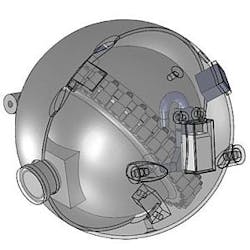Robot 'dives' into nuclear reactors to provide real-time inspection
A major challenge faced by those whoinspect underground pipes for nuclear reactors is identifying corrosion. Currently, plant inspectors use indirect methods to monitor buried piping, such as generating a voltage gradient to identify areas of corrosion and using ultrasonic waves to screen lengths of pipe for cracks.
At theMassachusetts Institute of Technology (MIT; Cambridge, MA, USA), professor Harry Asada is working on a direct monitoring alternative: a small robot designed to dive into nuclear reactors and swim through underground pipes. The camera-equipped robot is able to withstand a reactor’s extreme, radioactive environment, transmitting images in real time from within.
Asada’srobotic inspector looks like a small metallic cannonball. There are no propellers or rudders, or any obvious mechanism on its surface to power the robot through an underwater environment. Asada says such appendages are too bulky; a robot fitted with external thrusters or propellers would lodge in a reactor’s intricate network of pipes and joints.
The spherical robot uses a propulsion system that harnesses the force of water rushing through a reactor. Depending on the direction in which it is required to travel, water is directed through one of several valves within the hull of the robot, creating a jet stream that propels it along.
As the robot navigates a pipe system,an onboard camera takes images along the pipe’s interior. A two-axis gimbal in the body of the robot enables the robot’s center of mass to be changed arbitrarily. By doing so, the camera—fixed to the outside of the robot—can pan and tilt as the robot remains stationary. Asada’s original plan was to retrieve the robot and examine the images afterward. But now he is planning to equip the robot with a wireless underwater communication system to transmit images in real time across distances up to 100 m.
Asada envisions the robot as a short-term, disposable patroller, able to inspect pipes for several missions before breaking down from repeated radiation exposure.
-- Posted byVision Systems Design
